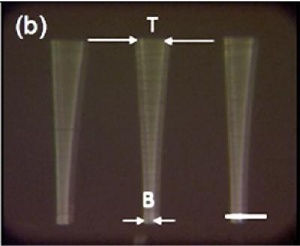Jun 30 2009
The equipment used for biomedical research is shrinking, but the physical properties of the fluids under investigation are not changing. This creates a problem: the reservoirs that hold the liquid are now so small that forces between molecules on the liquid's surface dominate, and one can no longer shake the container to mix two fluids. Instead, researchers must bide their time and wait for diffusion to occur.
 The artificial cilia are flexible rubber fingers less than 1/100 of an inch long, and 1/1000 of an inch wide. The tips shown here vibrate 65 times per second. Credit: University of Washington
The artificial cilia are flexible rubber fingers less than 1/100 of an inch long, and 1/1000 of an inch wide. The tips shown here vibrate 65 times per second. Credit: University of Washington
Scientists at the University of Washington hope to speed up biomedical reactions by filling each well with tiny beating rods that mimic cilia, the hairlike appendages that line organs such as the human windpipe, where they sweep out dirt and mucus from the lungs. The researchers created a prototype that mixes tiny volumes of fluid or creates a current to move a particle, according to research published in the journal Lab on a Chip. They used a novel underwater manufacturing technique to overcome obstacles faced by other teams that have attempted to build a similar device.
Diffusion, or random mixing of molecules, is slow but often the only option for mixing the small volumes that are increasingly common in modern biomedical research. A plate that once held 96 wells now can have 384 or 1,536 wells, each of which tests reactions on different combinations of liquids. The volume of liquid in each well of the 384-well plate is just 50 microliters, about the volume of a single drop of water.
"In order to mix water with juice, you can shake it, because the mass is very big," said Jae-Hyun Chung, a UW assistant professor of mechanical engineering and corresponding author of the paper. "(For the wells used in biomedical assays) you can't shake the well to mix two fluids because the mass of liquid in each well is very small, and the viscosity is very high."
The problem of mixing at small scales has confronted biomedical researchers for about 40 years, Chung said. Other strategies for mixing – shakers, magnetic sticks, ultrasonic systems, vortex machines – have not worked in biomedical research for various reasons, including the shear stress, the need to have a clear view of each well, and damage to the enzymes and biological molecules.
In the past decade, various research groups have tried to develop structures that mimic cilia, which do the small-scale moving and shaking inside the human body. The problem is that each cilium finger must be very flexible in order to vibrate – so delicate, in fact, that manufactured cilia of this size collapse as they are placed in water.
The UW team solved the problem by manufacturing the cilia underwater, Chung said. The resulting prototype is a flexible rubber structure with fingers 400 micrometers long (about 1/100 of an inch) that can move liquids or biological components such as cells at the microscopic scale.
The team varied the length and spacing of the fingers to get different vibration frequencies. When they now apply a small vibration to the surrounding water, the fingers on the UW prototype move back and forth at 10 to 100 beats per second, roughly the vibration frequency of biological cilia.
The results show the device can mix two fluids many times faster than diffusion alone and can generate a current to move small particles in a desired direction. A current could be used, for example, to move cells through a small-scale diagnostic test.
Co-authors are UW mechanical engineering doctoral student Kieseok Oh and mechanical engineering professors Santosh Devasia and James Riley. The research is funded by the National Science Foundation.
The team has obtained a provisional patent on the technology, and has funding from the UW's Royalty Research Fund to build a prototype 384-well plate lined with cilia. "We are currently trying to develop the technology for high-throughput biochemical applications," Chung said. "But we can also do micro-mixing and micro-pumps, which have many potential applications."